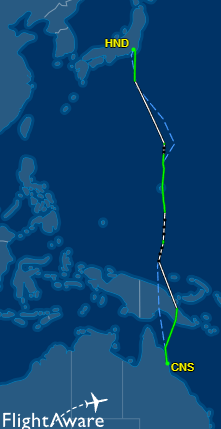- Joined
- Nov 16, 2004
- Posts
- 48,987
- Qantas
- Platinum
- Virgin
- Platinum
- Oneworld
- Emerald
Thanks for that; I found it quite informative.It was actually really good. Day one was a killer to get to CNS though (SYD BNE PPP BNE CNS). The trip to HND itself was really good. Really took me back to my long haul days and using CPDLC (datalink - a text messaging service with ATC) again.
The way up was quite uneventful and at 7hrs 35mins block it actually went quite fast being a day trip and we arrived early to gate 140 at terminal 3. The arrival is very busy and they actually descended us quite early (about 10mins early). As we got closer to intercepting the ILS speed control was the name of the game. ATC were absolutely on to anyone not doing the speed they needed and we were back at minimum approach speed at about 3000ft. Almost reminded me of the movie Pushing Tin.
I made the most of my 24hrs off here and took in the sights of downtown Tokyo. I was there in May for a holiday and loved being back. Japan is one of my favourite countries.
Arriving back at the airport the following night and back to gate 140, we pushed back and clogged the alleyway thanks to the LEAP-1B engines taking almost 2mins to start each engine. The taxi out to runway 05 took about 25mins and after briefing the convoluted departure it got cancelled as we approached the runway and just got a heading to maintain after we got airborne.
About an hour into the flight we passed a few storms thanks to the tail end of Hurricane JEBI, who we managed to stay clear of on the way up. The route then took us straight over GUM (we were crossing with QF60 up until that point) and were actually on VHF with the Americans for another hour keeping me awake.
It wasn’t until we hit the PNG coastline where we encountered a wall of thunderstorms almost the entire length of the country and spotted a comet when we turned to take 300nm off course to avoid! Luckily we took full tanks back to CNS.
To be honest, I actually really love flying the MAX it is much more stable, quieter, and rides turbulence better than the NG. The software comes with a few extra bells and whistles which I’m getting used to and it lands so much easier as well.
I’ve only had 2 days off and now heading up to BNE tomorrow for some upper air recovery procedures in the MAX sim. The focus on this one is having the airspeed unreliable at different phases of flight. This comes around every 2-3years and is in addition to our cyclic. It just helps with upset recoveries (stalls and unusual attitudes) and we do it in the MAX sim because it is capable of doing the manoeuvres with the motion still on (unlike the NG sim).
VA78 (VOZ78) Virgin Australia Flight Tracking and History 29-Sep-2024 (HND / RJTT-CNS / YBCS) - FlightAware
Track Virgin Australia (VA) #78 flight from Tokyo Int'l (Haneda) to Cairns Int'l















